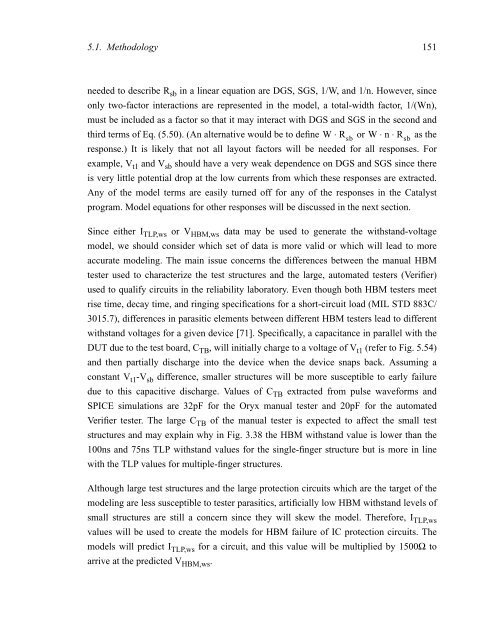characterization, modeling, and design of esd protection circuits
characterization, modeling, and design of esd protection circuits
characterization, modeling, and design of esd protection circuits
You also want an ePaper? Increase the reach of your titles
YUMPU automatically turns print PDFs into web optimized ePapers that Google loves.
5.1. Methodology 151<br />
needed to describe Rsb in a linear equation are DGS, SGS, 1/W, <strong>and</strong> 1/n. However, since<br />
only two-factor interactions are represented in the model, a total-width factor, 1/(Wn),<br />
must be included as a factor so that it may interact with DGS <strong>and</strong> SGS in the second <strong>and</strong><br />
third terms <strong>of</strong> Eq. (5.50). (An alternative would be to define W ⋅ Rsb or W ⋅n⋅ Rsb as the<br />
response.) It is likely that not all layout factors will be needed for all responses. For<br />
example, Vt1 <strong>and</strong> Vsb should have a very weak dependence on DGS <strong>and</strong> SGS since there<br />
is very little potential drop at the low currents from which these responses are extracted.<br />
Any <strong>of</strong> the model terms are easily turned <strong>of</strong>f for any <strong>of</strong> the responses in the Catalyst<br />
program. Model equations for other responses will be discussed in the next section.<br />
Since either ITLP,ws or VHBM,ws data may be used to generate the withst<strong>and</strong>-voltage<br />
model, we should consider which set <strong>of</strong> data is more valid or which will lead to more<br />
accurate <strong>modeling</strong>. The main issue concerns the differences between the manual HBM<br />
tester used to characterize the test structures <strong>and</strong> the large, automated testers (Verifier)<br />
used to qualify <strong>circuits</strong> in the reliability laboratory. Even though both HBM testers meet<br />
rise time, decay time, <strong>and</strong> ringing specifications for a short-circuit load (MIL STD 883C/<br />
3015.7), differences in parasitic elements between different HBM testers lead to different<br />
withst<strong>and</strong> voltages for a given device [71]. Specifically, a capacitance in parallel with the<br />
DUT due to the test board, CTB , will initially charge to a voltage <strong>of</strong> Vt1 (refer to Fig. 5.54)<br />
<strong>and</strong> then partially discharge into the device when the device snaps back. Assuming a<br />
constant Vt1-Vsb difference, smaller structures will be more susceptible to early failure<br />
due to this capacitive discharge. Values <strong>of</strong> CTB extracted from pulse waveforms <strong>and</strong><br />
SPICE simulations are 32pF for the Oryx manual tester <strong>and</strong> 20pF for the automated<br />
Verifier tester. The large CTB <strong>of</strong> the manual tester is expected to affect the small test<br />
structures <strong>and</strong> may explain why in Fig. 3.38 the HBM withst<strong>and</strong> value is lower than the<br />
100ns <strong>and</strong> 75ns TLP withst<strong>and</strong> values for the single-finger structure but is more in line<br />
with the TLP values for multiple-finger structures.<br />
Although large test structures <strong>and</strong> the large <strong>protection</strong> <strong>circuits</strong> which are the target <strong>of</strong> the<br />
<strong>modeling</strong> are less susceptible to tester parasitics, artificially low HBM withst<strong>and</strong> levels <strong>of</strong><br />
small structures are still a concern since they will skew the model. Therefore, ITLP,ws values will be used to create the models for HBM failure <strong>of</strong> IC <strong>protection</strong> <strong>circuits</strong>. The<br />
models will predict ITLP,ws for a circuit, <strong>and</strong> this value will be multiplied by 1500Ω to<br />
arrive at the predicted VHBM,ws .
















